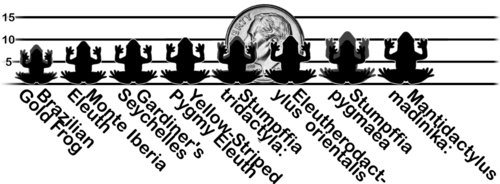Eleutherodactylus limbatus
| Yellow-striped pygmy eleuth | |
|---|---|
 |
|
| Scientific classification | |
| Kingdom: | Animalia |
| Phylum: | Chordata |
| Class: | Amphibia |
| Order: | Anura |
| Family: | Eleutherodactylidae |
| Genus: | Eleutherodactylus |
| Species: | E. limbatus |
| Binomial name | |
|
Eleutherodactylus limbatus (Cope, 1862) |
|
| Synonyms | |
|
Phyllobates limbatus Cope, 1862 |
|
Phyllobates limbatus Cope, 1862
Eleutherodactylus (Euhyas) limbatus (Cope, 1862)
Euhyas limbatus (Cope, 1862)
Measuring only 0.33–0.47 in (8.5–12 mm), the yellow-striped pygmy eleuth (Eleutherodactylus limbatus) is perhaps the fifth-smallest frog in the world.
E. limbatus has a very intense mating call, but it is brief (6.9 to 24.8 milliseconds) and high-pitched (6.5 to 8.3 kHz), at a rate of 278 per minute. Female frogs have a single ovary and lay one egg at a time, which is subsequently buried in the ground, where it develops quickly.
These frogs are found in Cuba at elevations up to 1,150 m above sea level, in closed-canopy mesic and xeric forests. Their distribution is highly fragmented, with the total land area equaling 7,700 mi2 (20,000 km2). Within this limited area, though, they are quite numerous.
...
Wikipedia


